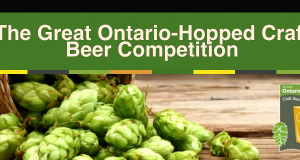This harvest, powdery mildew was detected on both cones and leaves of several varieties of hop in the Simcoe Research Station’s experimental yard.
While powdery mildew was historically a problem in northeastern North American hops, and continues to be a significant pest in the Pacific Northwest, we had not had significant issues with this disease since the resurgence of Ontario’s hops industry over the last decade. Last year, we detected a small number of powdery mildew infections on hops leaves towards the end of harvest (see this blog post for more information).
This year’s detection was significantly earlier than in 2014, and this is also the first time we have seen the disease on the cones in southwestern Ontario. Hops growers should be scouting their fields for signs of this disease next year.
Hops powdery mildew on leaves and cones. Note the characteristic powdery white appearance of the spores.
Powdery mildew is caused by a fungus that is quite different from the species causing downy mildew of hops (which is actually not really a fungus – see this post on the difference between powdery and downy mildews). Because of this, most sprays applied to control downy mildew will not control powdery mildew. Additionally, powdery mildew requires only high humidity, not free water, to infect plants, so the disease can spread even without rainy weather. This species of powdery mildew is specific to hops and its close relatives, and is not the same as the powdery mildews of other crops such as grapes, cucumbers or strawberries.
Powdery mildew may initially appear on leaves as pale yellow spots which develop into colonies of powdery white spores. In contrast, downy mildew lesions produce dark purplish spores. Downy mildew lesions also sporulate only on the leaf underside, while powdery mildew will sporulate on both sides of the leaf.
Powdery mildew lesions on hops leaf
Powdery mildew will also affect the cones, which may also produce powdery white spores (as in the photo at the beginning of this post), however, sporulation is not always obvious. As infected cone tissue dies, it may become reddish-brown, and symptoms may be difficult to distinguish from downy mildew or Alternaria cone disorder, which is common in hops damaged by wind or other mechanical injury. In the Simcoe yard, Alternaria is also present, however it seems to be restricted to the tips of the bracts, giving the cones a striped appearance, while powdery mildew is more widespread throughout the cone.
Hops cones infected with powdery mildew (left) and alternaria cone disorder (right). Note the striped appearance and lack of powdery white spores on the cones infected with Alternaria.
In Ontario, several fungicides are registered for control or suppression of powdery mildew, however many have very long pre-harvest intervals and cannot be applied this close to harvest. Registered products are:
- MilStop and Sirocco (potassium bicarbonate – suppression, 0 day PHI)
- Pristine (boscalid + pyraclostrobin – control, also provides suppression of downy mildew, 46 day PHI)
- Purespray Green Oil (mineral oil – suppression, discontinue use at burr development)
- Quintec (quinoxyfen – control, 21 day PHI)
- Vivando (metrafenone – suppression, 14 day PHI)
Most of these products are preventative, so growers should be aware that applications will work mainly to prevent spread to uninfected tissue rather than reducing existing infections.
Sprays are unlikely to be effective in stopping infections already present on cones close to harvest. If significant infection is present on cones, consider an early harvest, which may reduce spread of the disease and damage to the cones.
For the complete post, and additional information, visit the Ontario speciality crop page here: https://onspecialtycrops.wordpress.com/author/onspecialtycrop/
 Ontario Hop Growers' Association The OHGA is a not-for-profit association of hop growers, families and enthusiasts who are interested in supporting the growth of the hop industry in Ontario.
Ontario Hop Growers' Association The OHGA is a not-for-profit association of hop growers, families and enthusiasts who are interested in supporting the growth of the hop industry in Ontario.




